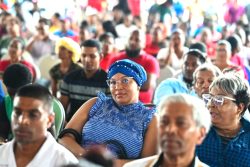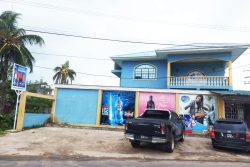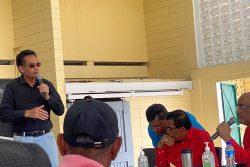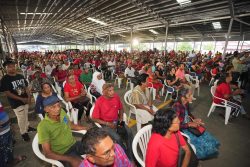Guardians of the past, they testify to the ordeals and exploits of those who worked in them. Industrial sites are important milestones in the history of humanity, marking humankind’s dual power of destruction and creation that engenders both nuisances and progress.
They embody the hope of a better life, and the ever-greater power over matter. The massive means employed to extract raw materials and exploit the minerals and agricultural products resulted in great achievements and grandiose constructions, testifying to the creative genius of humankind. Our industrial heritage includes not only the mill and factory, but also the social and engineering triumphs spawned by the new technologies: company towns, canals, railways, bridges and other forms of transportation and power engineering.
In Guyana, examples of such monuments include the following:
The Christianburg Waterwheel
Located in the mining town of Linden, which by itself can be identified as an industrial heritage centre, the Christianburg Waterwheel stands as a reminder of the once thriving logging operations of that area. Towards the end of the 18 century, the Dutch settled at Christianburg. This area, which was a former sugar estate, was originally known as Stabroek. Governor Christian Finette, who later renamed the area partly after his wife’s family, the Burgs, administered the settlement’s affairs during the early years of the 19th century.
In 1803, shortly after the English invasion, John Dagleish Patterson, a Scottish engineer was appointed to establish a quarters for government officials. Some time later Patterson acquired a small number of vessels from the indigenous peoples and commenced the production of logs. The first years were said to be extremely difficult. The logs were tied together and strung alongside a punt and floated downstream. This mode of production was dangerous and time consuming resulting in a high cost of production.
Despite these constraints, Patterson persevered, surveying Christianburg where he identified the Katabuli Creek as the ideal point of operation for the production of timber. The force of the water flowing through that creek from the savannahs into the Demerara River was strong enough to permit the construction of a hydro-powered sawmill.
In 1855, this large iron waterwheel was installed with the necessary equipment to allow Patterson to saw the logs before transporting them to Georgetown. Today, the Katabuli Creek is a mere trickle. The sawmill that was erected here, was dismantled and only the waterwheel remains. It is perhaps one of the best examples of the technology implemented to capitalize on the rich and natural environment of Guyana.
Stabroek Market
Taken in its entirety, the Stabroek Market can be considered an engineering and architectural masterpiece, a showpiece of Guyana’s industrial heritage. Covering an area of 76,728 square feet, length 278 feet and width 276 feet, the structure may well be the largest public market in the Caribbean and certainly ranks among the world’s largest all metal markets.
The present market is the third market and second structure erected. In 1870, as a result of the growth of commercial activity within the city, Mr Francis Conyers, a town councillor, recommended that a new market be erected to replace the then wooden structure, which had become overcrowded and dilapidated. In 1879, a committee consisting of His Worship, Mayor G A Forshaw, Messrs B S Bayley, J C Whitehead, H S Sprotson, Innis F A Conjers and Luke M Hill, the Town Superintendent, was appointed to examine and approve plans submitted by the prospective construction agencies through a system of tenders.
The plan, submitted by Nathaniel Mc Kay, an American, on behalf of the Edge Moor Iron Company of Philadelphia, USA was selected by the committee. On 17 July 1880, under the supervision of Town Superintendent, Luke M Hill, the construction of the market commenced. On 1 November 1881, with little fanfare, the market was declared open by Governor Korwright.
The building is essentially a steel framed structure, with the connected frames fabricated from sections and rolled into shape by ingots of hot steel with the industrial application of the Bessemer process, the first method for the mass production of steel by Henry Bessemer in 1865.
In 1881, the year of the markets completion, the use of steel was not a widely accepted method in the construction of buildings. In the eyes of one architect, this imposing structure was described as ‘pierced metal work over a skeleton or rolled and riveted steel girders.’ Today the market continues to thrive and almost anything can be purchased inside, one West Indian politician noted that the only thing missing was a church.
Public clocks
Guyana is also blessed with a fine representative selection of public clocks both in type and manufacture. The most imposing of Georgetown’s public clocks is the four-dial clock of the Stabroek Market. This clock, which resides some sixty feet above the ground in the market’s tower, was ordered from the E Howard Company of Boston, Massachusetts on 1 July 1880. This clock is one of two American manufactured clocks within the city, the other being that of the La Penitence market which was manufactured by the Seth Thomas Clock Company.
The Stabroek Market’s clock allows for the residents of the town to view the time from four directions. Three of the clock’s faces are aligned with the grid pattern of Georgetown’s streets, while the fourth gives time to shipping at the docks and the Demerara River, flowing along the market’s western facade.
This Howard Turret clock was originally designed to operate for up to eight days between windings and permitted the hours and half hours to be struck on a large steel bell exposed on the top of the tower beneath a canopy.
Other examples of the city’s public clocks include that of Bourda Market, which was built in 1902 by W Potts & Son of Leeds, Britain. The clock of the High Court recently repaired but yet to be installed, was constructed circa 1884. It was described as one of the most important clocks within the city as was the product of one of the most eminent horological businesses of the nineteenth century, that of Paul Philip Barraud, known chiefly for high grade watches and chronometers that came from his premises at Cornhill, London.
The clocks of Kitty market and the Guyana Post Office are the only two examples of electrical driven mechanisms within the city. Other examples of clocks within the city include the sundial once located within the National Park and the clock of Christ Church and the now dismantled or missing clock of the Georgetown Public Hospital.
In New Amsterdam, the All Saints Presbyterian Church is the only church with a clock in its steeple. Tradition has it that the clock, manufactured in London in 1815, was imported by a wealthy planter to be installed in the great house at one of his plantations. However, upon arrival it was determined that the clock was too heavy and could not be installed. In the circumstance, it was donated to the church. It is inscribed with the following words: ‘the gift of Woolfert Katz to the colony of Berbice.
Bridges
The appeal of bridges is universal. They serve as a link between the past and the future, a symbol of the nation’s patrimony. The railway bridges along the West Coast Berbice and the West Coast Demerara stand as the sole tangible reminders of the first railway constructed in South America.
The Mahaica and Mahaicony railway bridges once deemed as scrap metal, by the powers to be, both span 200 feet. They were both manufactured by Patent Shaft and Axeltree Company, Wednesbury in 1897. The Abary Railway Bridge, which rests on a base of reinforced bricks, spanning 100 feet, was erected in 1898. It permitted the extension of the Jameson Railway from Georgetown to the Berbice River. The Boeraserie Railway Bridge, a simple lattice girder steel bridge that measures 100
feet in length and 50 feet in width was manufactured by patent Shaft & Axeltree Company, Wednesbury in 1898. Like the Abary Bridge, it rests on a foundation of bricks. It was erected under the supervision if Mr. Dorman, the Chief Engineer of the Demerara Railway Company. The Boeraserie Bridge permitted the expansion of the company’s operation from Georgetown to Parika. This line was opened in 1914.
Whilst these bridges were all constructed during the colonial era, the Demerara Harbour Bridge stands out as one of the few engineering feats of the post independence era in Guyana’s history. To meet the increased needs of the populace the Government of Guyana decided, despite criticism, to construct a floating bridge with retractable spans across the Demerara River.
On May 24, 1976 three contracts were signed in London by the Guyana High Commissioner; one for the sale of the bridge components and the other two for bank financing for the purchase of the necessary supplies. On May 29, 1976, construction commenced and after 25 months, the 80,000-tonne steel structure, 6,074 feet long and 24 feet wide, was declared open by His Excellency Linden Forbes Sampson Burnham.
In a special newspaper supplement Mr S S Naraine, Minister of Works and Transport noted that “the completion of the bridge in 25 months is a tribute to Guyanese skill and engineering expertise. It is important to note that not only was the project manager a Guyanese, but eight out of the ten engineers who worked on the project were graduates from the Faculty of Technology of the University of Guyana”.
Canals
In addition to these monuments, the basic characteristics of the city and its environs can also be considered as a part of the nation’s industrial heritage. Take for example the Lamaha Canal, which supplies the city with its fresh water supply. The decision to dig this canal was undertaken after the proposal of James Russell, whose monument rests on the lawns of City Hall. Disastrous fires and chronic water woes led the council to quickly endorse the digging of this canal, which commenced in 1828.
In addition to this canal, many of the city’s canals, particularly those in historic Georgetown were the fruits of the arduous labour of the enslaved labourers, whose masters willingly dispensed their valuable services.
Seawalls
The seawall is another masterpiece representing the engineering feats undertaken to protect the low-lying coastal plain. Seawalls were found necessary as a result of the constant erosion of the land by the sea. The renowned historians James Rodway and Henry G Dalton noted that two estates Kierfield and Sandy Point, both listed as being in existence in 1792 were washed away in 1804.
In 1855 after the Kingston flood, it was decided that a more secure wall needed to be constructed in the circumstance. The construction of the wall, from the Round House, commenced in 1858. Labour was supplied by the convicts of the Penal Settlement at Mazaruni, and granite was also sourced from the same location. This section of the wall was completed in 1892.
The workings of the bauxite and gold mining industries together with the various aspects of the agricultural industry are all integral parts of Guyana’s industrial patrimony. It is envisioned that with the modernization of the Skeldon Estate that the existing estate factories aren’t left to the perils of time and the generous helpings of the scrap metal dealers. In other countries, agricultural tourism is being given a boost with tours to vineyards. Maybe it’s time that such a venture is explored in Guyana, In addition it is now fitting, given the fact that much of the nation’s heritage has disappeared, without a trace, that an Industrial Heritage Museum, as proposed at the now dilapidated Railway Station be seriously considered if the generations of tomorrow are to experience and understand their history.









